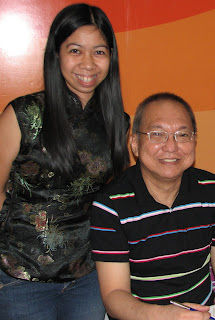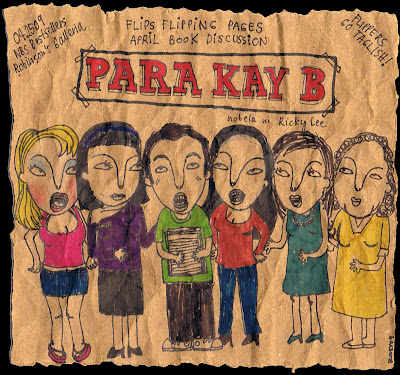
The fourth book I read during the 24-hour read-a-thon is
Para Kay B by Filipino scriptwriter Ricky Lee (book 63 of 2009, book 11 of diversity challenge- FFP book discussion selection), the assigned reading for April for my book club
Flips Flipping Pages, which will hold the discussion tomorrow (which prevents me from attending Dianne’s graduation party, but I’m really looking forward to the discussion).
Even before this book was chosen for discussion, I was meaning to get a copy because all the storefronts of National Book Store (to my international readers, NBS is the biggest book store chain in the Philippines) had a poster of the book and I was really intrigued by the full title, which reads: Para Kay B (O, kung paano dinedevastate ng pag-ibig ang 4 out of 5 sa atin) which roughly translated is: For B (Or how love devastates 4 out of 5 of us).
The novel, written in TagLish, a combination of Tagalog (a dialect which is the basis for the national language Filipino) and English, is comprised of five different love stories: a) Irene and Jordan (who made a childhood promise to marry her and then disappeared from her life); b) Sandra and Lupe (who happens to be her brother); c) Erica (who is from the love-less island of Maldiaga) and Jake (the son of the woman who takes Erica under her wing); d) the widow Ester and her maid Sara; and e) the voluptuous Bessie and the young, naive Lucas. The stories appear to be unrelated until the last few chapters, which reveal the link that binds them all.
Filipino was one of my better subjects in school (even in college when Filipino class was quite difficult), but reading this was harder for me than I anticipated because I haven’t read anything with this much Tagalog in a long time. To my non-Filipino readers, Tagalog (and Filipino) and the rest of the local dialects in the Philippines are read phonetically (sounded out syllable per syllable), as opposed to English, where words can be recognized on sight.
The second part I had difficulty with is the structure of the novel — no quotation marks. Quotes are mostly narrative, although there are some dialogues that read as a script. I have always had trouble reading novels that are straight narration (or with little dialogue) because I get bored, and when my concentration slips the text tends to meld together in my mind and I get lost reading. Perhaps it’s his background as a scriptwriter, or an intention to defy the conventional structure of the novel, but it took awhile before I got used to it.
During the readathon, the infernal heat was also driving me crazy so I had to haul my patootie to the McDonalds a few blocks away so I could concentrate.
The voice was also an acquired taste for me. When I read, I usually hear the narrator’s voice in my head (which I used to think was strange, but my Flipper friends tell me they do it too), and I hear a different pacing of the words for every book, and the voice and accent vary with the narrator (yes, Harry Potter in a British accent). I found Para Kay B too talkative, like the narrator was trying to get out so many words all at once, and I sensed a shrillness to it that grated on my nerves at some points in the book.
I liked the statistics proposed by the title, hahaha, because so far I’ve always been in the 4 out of 5 (loooooong story, and never mind) and I think a lot of people will agree with the statistic. In his end note, Ricky Lee states how (paraphrased) he wants to be read by everyone — the people riding the mrt, those watching over loved ones at the hospital, parents putting their kids to sleep — and not just his fellow writers or literature students. Love (or the absence of love) is a universal theme that most anyone can relate to, and Lee’s use of TagLish makes it more accessible to the average Filipino.
*Spoiler alert: do not read beyond this point if you plan on reading the book. Am writing about the resolution because a lot of my readers probably won’t get to read the book, seeing as it’s written in TagLish. I was contemplating writing this entry in TagLish like some of my Flipper friends but checking my stats, I found that only 41% of my readership is located in the Philippines, and I didn’t want to deprive them from reading this entry*
I did perk up later in the book when one of the characters (not Ricky Lee) turns out to be the writer of the five stories mentioned above. The stories are not resolved in their respective chapters, and are left hanging because of the writer’s (the character who is the writer, and not Ricky Lee) belief that 4 out of 5 love stories do not get a happy ending.
As the writer looks over his first draft, the 5 female characters suddenly appear in front of him, and they are disgruntled about the lack of resolution in their stories. They question his integrity and skill as a writer, fight among themselves, and even present the writer with a demand letter because they don’t want to be part of the 4 out of 5 statistic.
The character-talking-to-author ruse is a popular for stories about authors or illustrators, but I still found this to be the most enjoyable part of the novel because it was so funny in TagLish.
Finally, the writer issues his own demands — that the characters not pop up from out of the blue, that he write the story that he wants to tell, that he has the right to edit or revise as he chooses, and that the final say is his.
But he does change his mind about the story, and revises his draft to a conclusion that would satisfy both himself and his characters. He also realizes the difference between writing and real life, (paraphrased) how the writer has the power to change everything even after he’s written the story down — the bad changed to good and the tragic ending made happy — while in real life, that’s it, no revisions (I like this passage a lot).
Towards the end of the novel, he brushes off his theory on love, stating that theories are for insecure people, but he backtracks, posing the question, who isn’t insecure when they’re in love?
Edit at 11:24 pm: Am clarifying why I like this last part (more than the rest of the novel) after reading Gege’s review because I realized I didn’t elaborate on this aspect to the story.
My reading of the novel is that it’s an attempt (albeit it comes off a bit contrived, very movie-ish) at postmodernism, defying the traditional structure of the novel: one of the characters turns out to be writing the story (but is not the author), the characters become self-aware (that they’re characters of the story), voice out exactly what they think of the story (and attempt to vote off the writer) and have a hand in manipulating the outcome.
As the Flippers well know, I like postmodernist techniques in books (whether it’s picture books or novels) and I was pleasantly surprised to find it in this book because I wasn’t sure I was going to like it.
Para Kay B wasn’t exactly my cup of tea, but in the end I enjoyed it, and I’m glad the discussi
on moved it up my reading list. I’m looking forward to discussing it tomorrow and meeting Ricky Lee in person.
One last, a drawing I made for the journal (token) we’re giving Ricky Lee at the discussion tomorrow. Will post some photos of the event in another entry this weekend :)
Oh, and props to INKie Ivan Reverente for the great illustrations, and I’m glad he joined us at INK this year.
It was a great discussion, revealing juicy secrets (please, let’s keep everything in confidence!) among the attendees, discussing which chapters we liked best from the book, love, character stereotypes, colloquialism, and Filipino reading habits.



